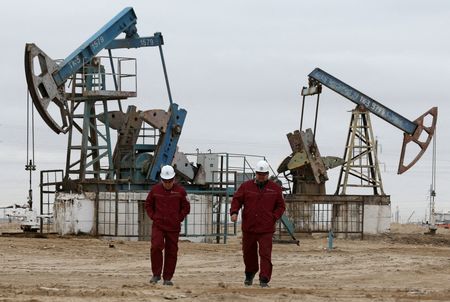
By Arathy Somasekhar
HOUSTON (Reuters) -Oil prices rose nearly 1.5% on Friday, posting a second straight weekly increase as impending European Union sanctions on Russian oil raised the prospect of tighter supply and had traders shrugging off worries about global economic growth.
Brent futures rose $1.49, or 1.3%, to settle at $112.39 per barrel. U.S. West Texas Intermediate (WTI) crude climbed $1.51, or 1.4%, to end at $109.77 a barrel.
“In the near term, the fundamentals for oil are bullish and it is only fears of an economic slowdown in the future that is holding us back,” said Phil Flynn, an analyst at Price Futures Group.
For the week, WTI gained about 5%, while Brent nearly 4% after the EU set out an embargo on Russian oil as part of its toughest-yet package of sanctions over the conflict in Ukraine.
The EU is tweaking its sanctions plan, hoping to win over reluctant states and secure the needed unanimous backing from the 27 member countries, three EU sources told Reuters. The initial proposal called for an end to EU imports of Russian crude and oil products by the end of this year.
“The looming EU embargo on Russian oil has the makings of an acute supply squeeze. In any case, OPEC+ is in no mood to help out, even as rallying energy prices spur harmful levels of inflation,” PVM analyst Stephen Brennock said.
Ignoring calls from Western nations to hike output more, the Organization of the Petroleum Exporting Countries, Russia and allied producers (OPEC+), stuck with its plan to raise its June output target by 432,000 barrels per day.
However, analysts expect the group’s actual production rise to be much smaller due to capacity constraints.
“There is zero chance of certain members filling that quota as production challenges impact Nigeria and other African members,” said Jeffrey Halley, senior market analyst Asia Pacific at OANDA.
On Thursday, a U.S. Senate panel advanced a bill that could expose OPEC+ to lawsuits for collusion on boosting oil prices.
On the supply side, U.S. oil rig count, an early indicator of future output, rose five to 557 this week, the highest since April 2020. []RIG/U]
Money managers cut their net long U.S. crude futures and options positions in the week to May 3, the U.S. Commodity Futures Trading Commission (CFTC) said.
Investors expect higher demand from the United States this autumn as Washington unveiled plans to buy 60 million barrels of crude to replenish emergency stockpiles. Yet signs of a weakening global economy fed demand concerns, limiting oil price gains.
On Thursday, the Bank of England warned Britain risks a double-whammy of a recession and inflation above 10%. It raised interest rates a quarter of a percentage point to 1%, their highest since 2009.
Strict COVID-19 curbs in China are creating headwinds for the world’s second-largest economy and leading oil importer.
Beijing authorities said all non-essential services would shut in its biggest district Chaoyang, home to embassies and large offices.
(Additional reporting by Rowena Edwards in London, Florence Tan in Singapore and Laura Sanicola in New YorkEditing by Marguerita Choy and David Gregorio)

